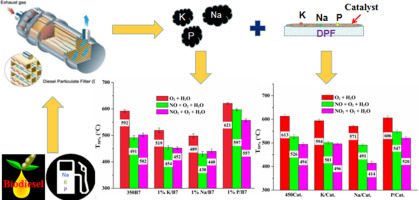当前位置:
X-MOL 学术
›
Fuel Process. Technol.
›
论文详情
Our official English website, www.x-mol.net, welcomes your feedback! (Note: you will need to create a separate account there.)
Effect of Biodiesel impurities (K, Na, P) on non-catalytic and catalytic activities of Diesel soot in model DPF regeneration conditions
Fuel Processing Technology ( IF 7.5 ) Pub Date : 2020-03-01 , DOI: 10.1016/j.fuproc.2019.106293 Hailong Zhang , Jishuang He , Shanshan Li , Eduard Emil Iojoiu , Maria Elena Galvez , Haifeng Xiong , Patrick Da Costa , Yaoqiang Chen
Fuel Processing Technology ( IF 7.5 ) Pub Date : 2020-03-01 , DOI: 10.1016/j.fuproc.2019.106293 Hailong Zhang , Jishuang He , Shanshan Li , Eduard Emil Iojoiu , Maria Elena Galvez , Haifeng Xiong , Patrick Da Costa , Yaoqiang Chen

|
Abstract The impact of Biodiesel impurities (Na, K and P) on the non-catalytic and catalytic reactivity of Diesel soot was evaluated under model DPF (Diesel Particulate Filter) regeneration conditions. Temperature-programmed oxidation (TPO) measurements confirmed that Na and K depositing into soot or on the surface of the catalyst enhanced the oxidative reactivity of soot under both O2 and NOx + O2 and Na-doped samples showed better results. However, the presence of P inhibited the non-catalytic and catalytic reactivity. These findings can be mainly attributed to the changes in nanostructure and surface chemical properties of the doped samples, characterized by Raman, high-resolution transmission electron microscopy (HRTEM), X-ray photoelectron spectroscopy (XPS), H2 temperature-programmed reduction (H2-TPR) and NO temperature-programmed oxidation (NO-TPO). The result of this characterization evidenced that the presence of Na and K increased structural defects of soot and reduction ability of the catalyst. Moreover, Na-/K-doped catalysts presented higher oxidizing ability of NO into NO2, whereas the opposite trend was observed for the P-containing catalysts. In addition, higher structural disorder of Na-doped soot and higher alkali metal content on the surface of Na-doped catalyst might lead to enhanced reactivity in comparison to K-doped soot and catalyst.
中文翻译:

在模型 DPF 再生条件下,生物柴油杂质(K、Na、P)对柴油碳烟非催化和催化活性的影响
摘要 在模型 DPF(柴油颗粒过滤器)再生条件下,评估了生物柴油杂质(Na、K 和 P)对柴油碳烟非催化和催化反应性的影响。程序升温氧化 (TPO) 测量证实,Na 和 K 沉积到烟灰中或催化剂表面上,在 O2 和 NOx + O2 和 Na 掺杂的样品下都增强了烟灰的氧化反应性,并且显示出更好的结果。然而,P 的存在抑制了非催化和催化反应。这些发现主要归因于掺杂样品的纳米结构和表面化学性质的变化,通过拉曼、高分辨率透射电子显微镜 (HRTEM)、X 射线光电子能谱 (XPS)、H2 程序升温还原 (H2-TPR) 和 NO 程序升温氧化 (NO-TPO)。该表征的结果证明Na和K的存在增加了烟灰的结构缺陷和催化剂的还原能力。此外,Na-/K 掺杂的催化剂表现出更高的 NO 氧化成 NO2 的能力,而含 P 的催化剂则观察到相反的趋势。此外,与 K 掺杂的烟灰和催化剂相比,Na 掺杂的烟灰的更高结构无序和 Na 掺杂催化剂表面上更高的碱金属含量可能导致反应性增强。而对于含 P 催化剂观察到相反的趋势。此外,与 K 掺杂的烟灰和催化剂相比,Na 掺杂的烟灰的更高结构无序和 Na 掺杂催化剂表面上更高的碱金属含量可能导致反应性增强。而对于含 P 催化剂观察到相反的趋势。此外,与 K 掺杂的烟灰和催化剂相比,Na 掺杂的烟灰的更高结构无序和 Na 掺杂催化剂表面上更高的碱金属含量可能导致反应性增强。
更新日期:2020-03-01
中文翻译:

在模型 DPF 再生条件下,生物柴油杂质(K、Na、P)对柴油碳烟非催化和催化活性的影响
摘要 在模型 DPF(柴油颗粒过滤器)再生条件下,评估了生物柴油杂质(Na、K 和 P)对柴油碳烟非催化和催化反应性的影响。程序升温氧化 (TPO) 测量证实,Na 和 K 沉积到烟灰中或催化剂表面上,在 O2 和 NOx + O2 和 Na 掺杂的样品下都增强了烟灰的氧化反应性,并且显示出更好的结果。然而,P 的存在抑制了非催化和催化反应。这些发现主要归因于掺杂样品的纳米结构和表面化学性质的变化,通过拉曼、高分辨率透射电子显微镜 (HRTEM)、X 射线光电子能谱 (XPS)、H2 程序升温还原 (H2-TPR) 和 NO 程序升温氧化 (NO-TPO)。该表征的结果证明Na和K的存在增加了烟灰的结构缺陷和催化剂的还原能力。此外,Na-/K 掺杂的催化剂表现出更高的 NO 氧化成 NO2 的能力,而含 P 的催化剂则观察到相反的趋势。此外,与 K 掺杂的烟灰和催化剂相比,Na 掺杂的烟灰的更高结构无序和 Na 掺杂催化剂表面上更高的碱金属含量可能导致反应性增强。而对于含 P 催化剂观察到相反的趋势。此外,与 K 掺杂的烟灰和催化剂相比,Na 掺杂的烟灰的更高结构无序和 Na 掺杂催化剂表面上更高的碱金属含量可能导致反应性增强。而对于含 P 催化剂观察到相反的趋势。此外,与 K 掺杂的烟灰和催化剂相比,Na 掺杂的烟灰的更高结构无序和 Na 掺杂催化剂表面上更高的碱金属含量可能导致反应性增强。


























 京公网安备 11010802027423号
京公网安备 11010802027423号